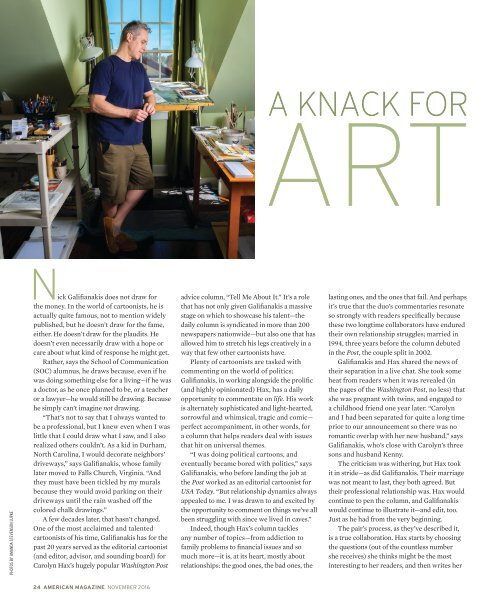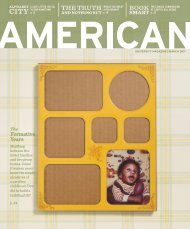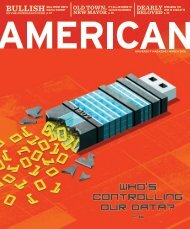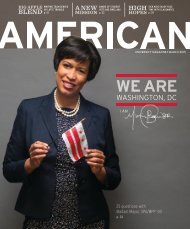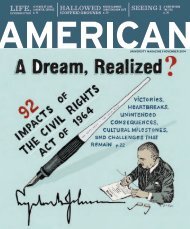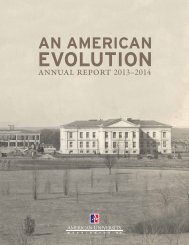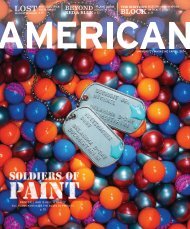American Magazine: November 2016
In this issue, delve into the Scandal-ous life of Judy Smith, meet ESPN’s new public editor, reflect on a decade of transformation under President Neil Kerwin, and learn more about autism—the fastest growing developmental disorder in the United States. Hop on the Metro to Capitol South and get to know a few of AU’s 1,068 Seattle transplants.
In this issue, delve into the Scandal-ous life of Judy Smith, meet ESPN’s new public editor, reflect on a decade of transformation under President Neil Kerwin, and learn more about autism—the fastest growing developmental disorder in the United States. Hop on the Metro to Capitol South and get to know a few of AU’s 1,068 Seattle transplants.
You also want an ePaper? Increase the reach of your titles
YUMPU automatically turns print PDFs into web optimized ePapers that Google loves.
PHOTOS BY AMANDA STEVENSON LUPKE<br />
Nick Galifianakis does not draw for<br />
the money. In the world of cartoonists, he is<br />
actually quite famous, not to mention widely<br />
published, but he doesn’t draw for the fame,<br />
either. He doesn’t draw for the plaudits. He<br />
doesn’t even necessarily draw with a hope or<br />
care about what kind of response he might get.<br />
Rather, says the School of Communication<br />
(SOC) alumnus, he draws because, even if he<br />
was doing something else for a living—if he was<br />
a doctor, as he once planned to be, or a teacher<br />
or a lawyer—he would still be drawing. Because<br />
he simply can’t imagine not drawing.<br />
“That’s not to say that I always wanted to<br />
be a professional, but I knew even when I was<br />
little that I could draw what I saw, and I also<br />
realized others couldn’t. As a kid in Durham,<br />
North Carolina, I would decorate neighbors’<br />
driveways,” says Galifianakis, whose family<br />
later moved to Falls Church, Virginia. “And<br />
they must have been tickled by my murals<br />
because they would avoid parking on their<br />
driveways until the rain washed off the<br />
colored chalk drawings.”<br />
A few decades later, that hasn’t changed.<br />
One of the most acclaimed and talented<br />
cartoonists of his time, Galifianakis has for the<br />
past 20 years served as the editorial cartoonist<br />
(and editor, advisor, and sounding board) for<br />
Carolyn Hax’s hugely popular Washington Post<br />
advice column, “Tell Me About It.” It’s a role<br />
that has not only given Galifianakis a massive<br />
stage on which to showcase his talent—the<br />
daily column is syndicated in more than 200<br />
newspapers nationwide—but also one that has<br />
allowed him to stretch his legs creatively in a<br />
way that few other cartoonists have.<br />
Plenty of cartoonists are tasked with<br />
commenting on the world of politics;<br />
Galifianakis, in working alongside the prolific<br />
(and highly opinionated) Hax, has a daily<br />
opportunity to commentate on life. His work<br />
is alternately sophisticated and light-hearted,<br />
sorrowful and whimsical, tragic and comic—<br />
perfect accompaniment, in other words, for<br />
a column that helps readers deal with issues<br />
that hit on universal themes.<br />
“I was doing political cartoons, and<br />
eventually became bored with politics,” says<br />
Galifianakis, who before landing the job at<br />
the Post worked as an editorial cartoonist for<br />
USA Today. “But relationship dynamics always<br />
appealed to me. I was drawn to and excited by<br />
the opportunity to comment on things we’ve all<br />
been struggling with since we lived in caves.”<br />
Indeed, though Hax’s column tackles<br />
any number of topics—from addiction to<br />
family problems to financial issues and so<br />
much more—it is, at its heart, mostly about<br />
relationships: the good ones, the bad ones, the<br />
lasting ones, and the ones that fail. And perhaps<br />
it’s true that the duo’s commentaries resonate<br />
so strongly with readers specifically because<br />
these two longtime collaborators have endured<br />
their own relationship struggles; married in<br />
1994, three years before the column debuted<br />
in the Post, the couple split in 2002.<br />
Galifianakis and Hax shared the news of<br />
their separation in a live chat. She took some<br />
heat from readers when it was revealed (in<br />
the pages of the Washington Post, no less) that<br />
she was pregnant with twins, and engaged to<br />
a childhood friend one year later. “Carolyn<br />
and I had been separated for quite a long time<br />
prior to our announcement so there was no<br />
romantic overlap with her new husband,” says<br />
Galifianakis, who’s close with Carolyn’s three<br />
sons and husband Kenny.<br />
The criticism was withering, but Hax took<br />
it in stride—as did Galifianakis. Their marriage<br />
was not meant to last, they both agreed. But<br />
their professional relationship was. Hax would<br />
continue to pen the column, and Galifianakis<br />
would continue to illustrate it—and edit, too.<br />
Just as he had from the very beginning.<br />
The pair’s process, as they’ve described it,<br />
is a true collaboration. Hax starts by choosing<br />
the questions (out of the countless number<br />
she receives) she thinks might be the most<br />
interesting to her readers, and then writes her<br />
24 AMERICAN MAGAZINE NOVEMBER <strong>2016</strong>


